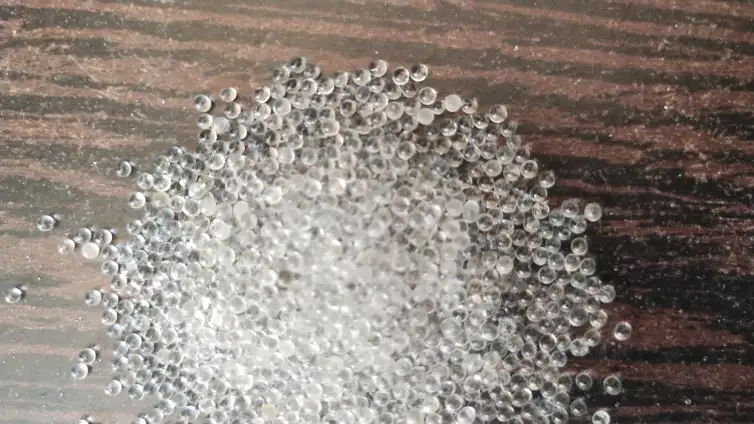Products

*Price Range - Rs 10-100 per/kg
4.0 Star Rating by our Precious Clients



Big Glass beads are made in a variety of ways in other countries. In different parts of India, techniques are highlighted, as are the processes adopted, which are mainly recognized by indigenous or traditional glass bead manufacturers. The researchers employed both experimental and descriptive research methodologies. In this study, keeping a close eye on the materials, tools, equipment, and technique was crucial.
Large glass beads in the shape of seed beads are known as big glass beads. They are frequently made of glass, plastic, or wood, are frequently wrongly referred to be pony beads, and are larger than pony beads.
Glass Beads price mainly depends upon the quality & capacity of the beads i.e, the number of times it can be recycled, generally, a good quality glass bead can be repeated 4-5 times in a cabinet blasting machine. We are the best wholesalers & manufacturers of all types of glass beads and shot blasting machine all over India like Jodhpur, Jaipur, Ahmedabad, Pune, Delhi, Faridabad, Gurgaon, and Kolhapur, we also provide glass beads & blasting machines on an urgent basis according to customer’s requirement, here you will get the best quotation of price from the rest.
We are the big glass beads manufacturers of different types & sizes of big glass beads, we manufacture glass beads for sandblasting, shot blasting, road marking, etc. The glass beads industry values the big glass beads that are available for purchase in India as additives. Big glass beads that boost rigidity and impact stability, enhance the beauty of the outer coating, and increase abrasion resistance are available for purchase in India.
By leaving for their inhomogeneity uninjected decorative components, large glass beads for sale in India lessen distorting and engaging effects as well as cloacal repercussions. Large glass beads are frequently utilised in India in technical components, exterior and interior auto parts, and 3D printed goods.
Abrasive materials are recycled by big glass bead manufacturers, who are frequently visible in blast rooms. Because there is no free iron to induce degeneracy on the base element outer integrating, 2mm glass beads made in India are very good to use on all kinds of metals.
Pieces of big glass beads, wood for fueling the kilns, metal mortar, pestle, grinding stone, bodkin, holder, and bricks are some of the components used to make small glass beads.
Bottles of a specific make that are compatible with other composite materials like ceramic and other powdered pigments whenever they are subjected to high temperatures are the major materials and other resources required.
The bottles are bought by agents who go from house to home looking for these bottles to buy, and some are even imported from Europe because not all of the colours are accessible locally. Ceramic or powdered pigment, as well as firewood for the kiln, are among the local resources. Typically, local resources are used to create the kiln.
The bottles are cleaned and sorted to see if they are compatible. The big glass beads are then crushed into powder in a metallic mortar after being broken into bits with a metallic pestle. The powder is sieved, and the smooth grains, which may pass through 300 grades, are collected before being pigmented.
This is where the colour scheme is decided, followed by the firing. The molten liquid glass is put into moulds while still hot. One form of mould has a metal rod running through its centre. The mould in another variant has multiple bowl-shaped shapes. The centre of the bowl-shaped depression was filled with a piece of the cassava leaf stalk. It is then allowed to cool.
It is then collected, cleansed, and dried after being burned in a specially designed tumbler. After that, it's annealed and maintained. The Descriptive method was used to describe the tools and materials used in big glass bead making, as well as the many types of big glass beads cost and the different processes used to make them.
Clay was obtained from a riverside clay pit to prepare the mould for casting large glass beads. The clay was allowed to dry completely before being used. Significant bits of undesired debris, such as roots, leaves, wood, and pebbles, became easier to remove.
The next step was to pound the clay into a fine powder and screen it through a wire mesh to remove any minute particles of undesired elements. A small amount of water was added to the powdered clay to make it easier to manage. To eliminate the trapped air bubbles, a lump of clay was produced and kneaded. The clay lump was occasionally sliced through with a cutting wire or a sharp knife and examined to ensure that all air bubbles had been removed.
The parts were smashed together and the dough was kneaded once more. Following the preparation of the clay, a standard thickness slab was moulded, taking into account the size of the big glass beads to be created. To get the outline, a rectangular or circular object was placed on the slab and traced. The drawn shape or contour was carved off the clay slab with a sharp knife.
The cut shape was left to cure until it was leather-hard. A piece of wood has fashioned with a little projection at the tip while the formed clay pieces were setting. A piece of shaped wood called "foa" was used to construct cavities in the clay mould into which powdered glass would be poured later. When the clay slab had hardened, the formed tool was carefully set on top of it, upright and at a 90-degree angle. To make a pit, the device was carefully pressed into the slab. An extended pit was made by the tool's projection at the tip.
The threading hole in the big glass beads would be created subsequently by sticking a cassava stalk into this extension. Depending on the size of the big glass beads to be generated, this pit-making operation was repeated to make roughly 39 pits.
